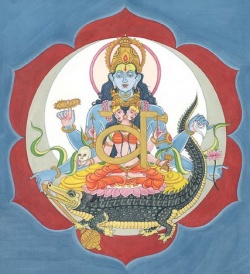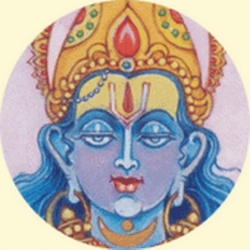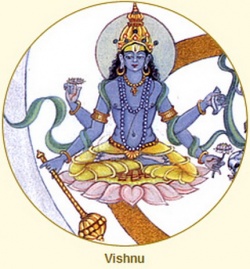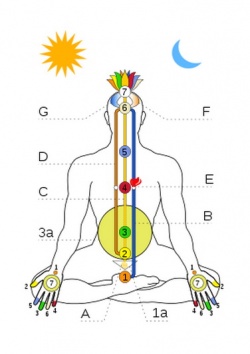Swadhisthana
Svadhisthana (Sanskrit: स्वाधिष्ठान, IAST: Svādhiṣṭhāna) called 'One's own abode' is the second primary chakra according to Hindu Tantrism.
Location
Svadhisthana is positioned at the tailbone, two finger-widths above Muladhara. It has six petals which match the following whirlpools of consciousness, also known as vrittis: affection, pitilessness, feeling of all-destructiveness, delusion, disdain and suspicion.
Its corresponding point in the front of the body (i.e. its kshetram) is at the pubic bone.
Appearance
Svadhisthana is described as a black lotus, with six vermillion coloured petals. Inside of this lotus is a white crescent moon, formed by two different sized inner circles, one inside of the other. The crescent moon is the water region, whose deity is Varuna, white in colour, four-armed, holding a noose and seated on a crocodile. The two inner circles also have petals, the larger one has eight outward facing petals, and the smaller one has eight inward facing petals.
Seed Mantra
The seed mantra, located in the innermost circle, is a moon-white वं vaṃ. Within the bindu, or dot, above the mantra is the deity Vishnu. He is shining dark blue, wears a yellow dhoti, and holds a conch, a mace, a wheel and a lotus. He wears the shriwatsa mark, and the koustabha gem. He is seated either on a pink lotus, or on the divine eagle Garuda. His Shakti is the goddess Rakini (or Chakini). She is dark black, dressed in a red or white sari, seated on a red lotus, and she is either one faced and two armed, holding a sword and a shield, or two faced and four armed, holding either a trident, lotus, drum and vajra, or an arrow, skull, drum and axe.
Petals
The six petals are vermillion, and have the following syllables written on them in the colour of lightning: बं baṃ, भं bhaṃ, मं maṃ, यं yaṃ, रं raṃ and लं laṃ. They represent the vṛttis of affection, pitilessness, feeling of all-destructiveness, delusion, disdain and suspicion.
Function
Svadhisthana is associated with the unconscious, and with emotion. It is closely related to Muladhara in that Svadhisthana is where the different samskaras (potential karmas), lie dormant, and Muladhara is where these samskaras find expression. It is associated with the element of water, the sense of taste, and the action of reproduction.
Svadhisthana contains unconscious desires, especially sexual desire, and it is said that to raise the kundalini shakti (energy of consciousness) above Svadhisthana is extremely difficult for this reason. Many saints have had to face the sexual temptations associated with this chakra.
Through meditation on Svadhisthana, the following siddhis or occult powers are said to be obtained. One is freed from all his enemies, and becomes a lord among yogis. His words flow like nectar in well-reasoned discourse. One gains loss of fear of water, awareness of astral entities, and the ability to taste anything desired for oneself or others.
Association with the body
The location of Svadhisthana is just in front of the spine, in the sacral region, and its kshetram or activation point is in the pubic region. Being connected with the sense of taste, it is associated with the tongue, and being connected with reproduction, it is associated with the genitals.
It is often associated with the endocrine organs of the testes or ovaries in men and women respectively. These produce the hormones testosterone or estrogen, which are important factors in sexual behaviour. These are also the locations the spermatoza or eggs are stored with their latent genetic information, like the latent samskaras that lie dormant within Svadhisthana.
Practices
Practices in kundalini yoga for controlling and balancing the energy in Svadhisthana chakra include vajroli mudra (contraction of the genitals), ashvini mudra (contraction of the anus), and various asanas and pranayamas.
Comparisons with other systems
The equivalent chakra in the Vajrayana highest tantra systems of Tibet is called the Secret Place, four fingers below the navel. It is red in colour, with 32 downward pointing spokes. Meditation on this point produces great bliss.
In the Sufi system of Lataif, there is an energy centre called the nafs, which is just below the navel. The nafs incorporates all the elements of man's 'lower self,' which must be tamed in order to attain closeness to Allah.
Western occultists make the kabbalistic association of Svadhisthana with the Sephirah Yesod. Yesod is also associated with the sexual organs. Its function in the tree of life is to gather the different energies that have been created in the descent down the tree and to distribute them to Malkuth, the material world, where the energy can find physical expression.
Alternative names
Tantra: Adhishthana, Bhima, Shatpatra, Skaddala Padma, Swadhishthana, Wari Chakra
Vedas (late Upanishads): Medhra, Swadhishthana
Puranic: Swadhishthana



